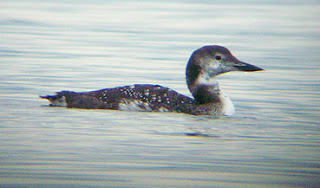Various auks were scattered around; pigeon guillemots, rhinoceros auklets and common murres in varying numbers.
A single marbled murrelet was seen and a common loon was fishing reasonably close inshore (pictured).
Few gulls were around, the majority now being mew gulls. A few California and glaucous-winged were loafing around, and just 3 Heermann's gulls were in the area. Following the mini-influx of Thayer's earlier in the week, there were none seen today.
Shorebirds wise, it was pretty dull - just 9 black turnstone and 2 surfbirds.
A single savannah sparrow was rummaging around, as were a couple of resident song sparrows.
5 harlequin ducks were paddling around and in Ross Bay, 8 surf scoter were present, as usual.
REMember The Good Bits
On a less avian note - news came through today that REM have split up. While many readers of this blog won't give a toss about that, I have been rather fond of the band for many years. It may be the case that their more recent work was a pale imitation of their earlier recordings, but nonetheless I shall honour them by sharing this, the most birdy of their songs (well it mentions swans and hummingbirds... what else do you want?). Incidentally, my blog title of a couple of days ago 'Fall On Me' was a timely reference to another REM song. Prescient or what?! Now, maybe I should choose a Nickelback song for my next post, and just keep my fingers crossed...


I dont know if you can help me or not but i was down at the esquimalt lagoon and there was some ducks i had to look at them thru my binochulors but they appeared to be brown speckled with a white chest and brown red head. Anyway there was about 15-20 of them and they were skimming through the water it looked like they were walking on the water it was the neates thing. I was wondering if you knew what kind of duck they might be.Thanks for your time and enjoy your birding!!!
ReplyDeleteHi Connie. Thanks for your message.
ReplyDeleteWithout having seen them myself, it's going to be hard to be certain, but from your description I would suggest that might be hooded mergansers.
In late summer/early autumn most ducks have a moult, growing a set of new feathers. During this time, they adopt a duller plumage (known as 'eclipse' plumage) and all appear much the same, despite their age or sex - hence no apparent males, with their gaudy colours would be seen among the flock.
Your description of their movements certainly suggests hooded merganser to me.
Try a Google images search and see what you think!
All the best
Jon